Winter Canoeing (Copyright © 2019 David Tilley)
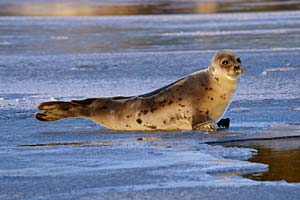 Living on the coast means year round access to open water and although it may take some initial getting use to, midwinter is one of the best times for sea canoeing. The constant winds that come with the hurricane season in mid September usually dissipate by December and some of the calmest days of the year make the open bays appealingly glassy and picture perfect for a relaxing paddle. The cold clear air and low angle of the sun makes for brilliant prolonged sunsets as the sky reddens to create sparkling reflections on the virgin snow and ice. Without a ripple on the water it is possible to spot the motion of seabirds as guillemots dive and skid the surface in the distance.
Living on the coast means year round access to open water and although it may take some initial getting use to, midwinter is one of the best times for sea canoeing. The constant winds that come with the hurricane season in mid September usually dissipate by December and some of the calmest days of the year make the open bays appealingly glassy and picture perfect for a relaxing paddle. The cold clear air and low angle of the sun makes for brilliant prolonged sunsets as the sky reddens to create sparkling reflections on the virgin snow and ice. Without a ripple on the water it is possible to spot the motion of seabirds as guillemots dive and skid the surface in the distance.
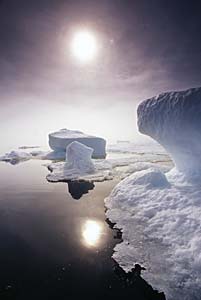
In January seals come to shore pulling out on frozen ledges that form early in shallow coves flush with fresh water from inflowing brooks. Occasional ice pans formed by the early freezing and breaking up of shore ice make convenient rafts for the carefree drifters. Loafing in the noonday sun they are practically oblivious and reluctant to give up their privileged position. Finally when the season opens and blood is spilled along the ice pans, rare Ivory Gulls as pure in colour as the virgin snow gather to scavenge the remainder of a fresh kill. The seal blood that stains the ice is a fortified feast to these gulls, who because of their remote arctic origin are extremely tame and trusting.
The seals having gained the population advantage in recent years are happy to loaf in full site of towns and traffic. Laying next to escape hatches they are quick to dive when a speedboat comes roaring close by. The holes well back from the ice edge are kept open and the newly formed ice is too weak to chance walking in from the open water. The canoe exhibits its adaptability once again when coupled with a pole and spike it can be pushed across the ice to a breathing hole where while lying low I can wait for an unwary seal to emerge from the icy depths. The bottling seals bob up and down like corks buoyed by powerful flippers as they strain for a better look.
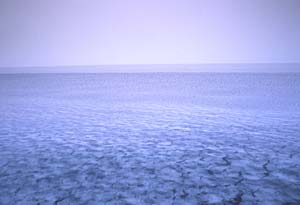 The eagles that nest and winter near open water are also winners during the sealing season, gaining much needed nutrition from the scraps of carrion left at a kill. First year birds, having yet to develop the hunting prowess of their parents stand to benefit the most. Gatherings of several birds adrift on a string of offshore ice are possible. The milder winters of recent years have kept the bays open, as well as the shoal wind protected arms that extend inland offering better fishing and hunting opportunities.
The eagles that nest and winter near open water are also winners during the sealing season, gaining much needed nutrition from the scraps of carrion left at a kill. First year birds, having yet to develop the hunting prowess of their parents stand to benefit the most. Gatherings of several birds adrift on a string of offshore ice are possible. The milder winters of recent years have kept the bays open, as well as the shoal wind protected arms that extend inland offering better fishing and hunting opportunities.
An extensive freeze up or buildup of sea ice in late winter, however pushes the eagles to the limit of their hunting range as the stress of winter on the North East coast reaches its peak. It is usually May before the spawning herring arrive with a variety of birds and marine mammals in tow. None too soon for the courting eagles, intent on raising another brood. The giant birds are not uncommon as they silently wing across the late day sky to roost in a not to distant but remote cove hidden beneath the towering cliffs that jut into the Atlantic.
As the wind dies on a frosty morning the water becomes heavy with slush acting as a barrier to wave action and damping the otherwise unsettled sea. Water kept from freezing by constant movement when driven by harsh winds is quick to freeze when the breezes stall and temperatures dip during the long winter night. If this was not enough of a concern, shifting breezes can drive heavier ice onshore to block the mouths of coves leaving the boat stranded on the water. Trying to weave through irregularly packed ice is difficult in an 18 foot canoe. A combination of paddling and portaging across the ice pans finally gains the shoreline and a better appreciation for the changing winds. Open channels harden to ice sheets 3" thick in an hour. Pushing through ice this thick can take considerable time as the ice gets heavier and progress becomes more and more difficult. Waiting for solid ice to haul out or winds to force a breakup is not an option when sitting in subzero temperatures. Narrow arms and shoals that traditionally freeze should be avoided at these times. Following a channel left open by a heavier speed boat is certain trouble.
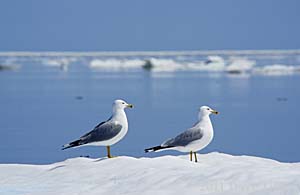 Seals can be located by watching congregations of seabirds as they follow schools of fish. Whales are best found in this same way as many birds and mammals can coexist with a massive school. Whales in recent years are believed to have moved up the food chain from taking capelin to now taking herring and other larger fish. The more erratic movements of herring makes for a tremendous show as Humpback whales race in and out, breaching and diving in the fjord of SW Arm. A pair of whales move in a synchronized display of fishing prowess. Diving deeply while venting their lungs the percolating bubbles froth the surface to trap fish in a funnel. The boiling water is suddenly broken as the huge whale emerges with open stretched mouth spewing tons of seawater as the fish are netted between baleen plates. The whale rolls as its long white fin churns the water into a quickening vortex. The drama of the event, highlighted by the contrasting stillness of surrounding water that mirrors silent cliffs looming above the fjord.
Seals can be located by watching congregations of seabirds as they follow schools of fish. Whales are best found in this same way as many birds and mammals can coexist with a massive school. Whales in recent years are believed to have moved up the food chain from taking capelin to now taking herring and other larger fish. The more erratic movements of herring makes for a tremendous show as Humpback whales race in and out, breaching and diving in the fjord of SW Arm. A pair of whales move in a synchronized display of fishing prowess. Diving deeply while venting their lungs the percolating bubbles froth the surface to trap fish in a funnel. The boiling water is suddenly broken as the huge whale emerges with open stretched mouth spewing tons of seawater as the fish are netted between baleen plates. The whale rolls as its long white fin churns the water into a quickening vortex. The drama of the event, highlighted by the contrasting stillness of surrounding water that mirrors silent cliffs looming above the fjord. 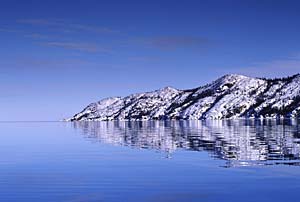 In late may as the herring finally crowd the shoals, the whales come steaming through with a company of herring gulls circling. Moving upwind from a small chunk of ice I float slowly towards a pair of screaming terns who watch the gannets, seals, grampus and whales, as much observers as participants in this natural spectacle. The no longer hunted seals swim in giant herds, sweeping in wide circles in a combined effort to quarry the schools of fish. Gannets are equally impressive in their kamikaze routine of plummeting from a height to shoot through the marine environment at speeds rivalling their over water abilities. All this, while a few remaining rafts of winter sea ice drift amongst the first arrivals of Greenland icebergs that have come to inundate the coast until midsummer. The ice is at the centre of this congregation of relentless fishers who plunder the oceans spoils for many happy weeks as the spring thaw sees a renewal of life in Green Bay, Newfoundland.
In late may as the herring finally crowd the shoals, the whales come steaming through with a company of herring gulls circling. Moving upwind from a small chunk of ice I float slowly towards a pair of screaming terns who watch the gannets, seals, grampus and whales, as much observers as participants in this natural spectacle. The no longer hunted seals swim in giant herds, sweeping in wide circles in a combined effort to quarry the schools of fish. Gannets are equally impressive in their kamikaze routine of plummeting from a height to shoot through the marine environment at speeds rivalling their over water abilities. All this, while a few remaining rafts of winter sea ice drift amongst the first arrivals of Greenland icebergs that have come to inundate the coast until midsummer. The ice is at the centre of this congregation of relentless fishers who plunder the oceans spoils for many happy weeks as the spring thaw sees a renewal of life in Green Bay, Newfoundland.
